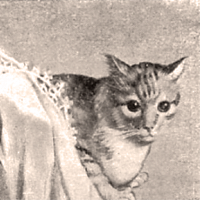It has been a difficult one for me to do. While at the EGA Seminar a few weeks ago, I sat with Signora Derna and watched her execute a Rolled Hem on the Assisi Embroideries that she was making. Fascinated, I watched her again and again. She made it look so effortless... so easy.
I didn't make any notes and couldn't take any photos - she was so fast! I still don't know if I'm doing it like she did. I checked through my books and found at least three different methods for executing the Rolled Hem.
Fundamentally they all begin the same way. With spit. Yes, I said spit. I have had more than one maestra tell me this. If you lick your floss when you thread your needle, you won't be too grossed out, if not, well... you need to get over it. Spit washes out. Water dampening your fingers works eventually, but not nearly as well, and you almost always get your fingers too wet. What helped me get it was using a high count fabric first until I got the hang of it, and then trying a more openweave fabric.
Yesterday a reader asked me to explain how to do the Rolled Hem so I'm going to attempt it here for her and any others who may be interested, please remember that this is only one of many ways to do it.
I'm demonstrating on 38ct Sotema ivory-coloured linen 20L, which is my favourite linen right now. It's a beautiful weight of fabric and very compactly woven.
First, I withdrew one fabric ground thread about 10 ground threads in from the edge of my fabric (make sure your cut is straight!). Then I skipped four ground threads and withdrew another one. This is the setup for doing the Four-Sided Stitch which is usually found in combination with a Rolled Hem on Assisi work. If I had more time, I would do the Four-Sided Stitch first to group my threads into squares over four ground threads.
Working on the back side of the work, I licked the tip of my index finger and thumb on my left hand and taking the edge of the fabric between the two, squeezed and rolled the hem up a little. You don't have to do too much, like only a couple of inches along the edge at a time. My first roll was a little fat, so I just re-rolled it squeezing a little tighter with my fingers and the roll tightened up. This is such beautiful fabric, the edge didn't even start to fray:

Don't start at the very bottom, but a little above and just keep rolling and squeezing until you get some control. The motion of it reminds me of the way an old boyfriend used to roll his cigarettes.
Using a sharp needle (I think the one I'm using is a no. 7, but it can be smaller - it probably should be at least a no. 8 or 9 but it's what I have handy right now) and some n. 50 crochet cotton thread because it was handy, (you can use floss or Pearl cotton n.12 or finer crochet cotton or even sewing thread) I let a couple of inches of the tail of my thread lay in the part that would be rolled up and came out with my needle about two ground threads into my roll. Working from bottom to top in direction, I entered with the needle into the withdrawn thread channel four ground threads up from where I exited in the roll and skipping four ground threads I exited with the needle like so:

My original exit position in the roll should be about level with my exit position in the withdrawn channel. Then going up to where I entered the withdrawn channel, I enter with my needle into the roll, keeping the same distance as before (about two ground threads), the needle goes between the roll and the fabric, that is, you never come out on the front side when entering into the roll.
Okay, I swear that I only came out at a distance of two ground threads into the roll but while trying to position the camera my roll came slightly undone - it's hard to do this and take close-up photos with only two hands! Everything is stitched with the fabric over your index finger.

I'm working directionally along the edge from bottom to top but I thought Signora Derna worked top to bottom and came out already into her roll... that is, without taking a separate step like I'm doing here, but I just don't seem to be able to figure that out right now.
Remember: when going into the roll, you never pierce your ground fabric so that the stitch will be visible from the front. Here is what a little bit of Rolled Hem looks like from the front:

This is how it looks on the back. Click on the photos for a closer look:

And here we have a bit of Four-Sided Stitch beside the Rolled Hem:

Sorry my photos aren't better, my photographer is not home this afternoon and I probably should have used coloured thread! See? I'm learning too!
Does this help at all?

























